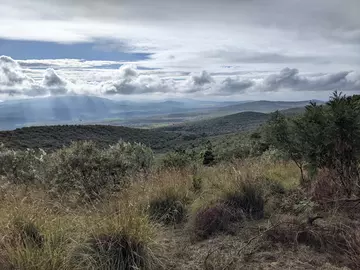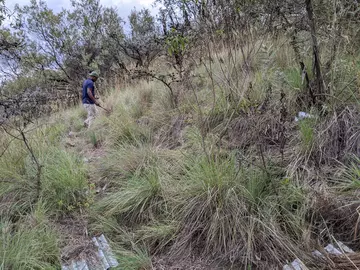
Viper Research in Kenya
Dickson Katana and Daniel Kane
Kenya is renowned for its amazing landscapes, vibrant cultures and diverse wildlife. Among its most enigmatic inhabitants are snakes, and in September I travelled there to visit Dickson Katana – an EDGE Fellow who’s project focuses on the endemic Kenyan horned viper (Bitis worthingtoni). Together with Dickson and his project supervisor, Mirthe, we spent time refining the project. The key component of this was searching for vipers, contributing to a media database, and using state of the art software to identify individual snakes.

Kenyan horned viper
The Kenyan horned viper is a small species of snake – rarely growing to greater than 50 cm long – and is confined to Kenya’s rift valley area. Known populations exist from around 1,500 m to 2,400 m and appear to be associated with grassland and leleshwa forest. Very little is known about this species in the wild, with simple life history traits such as diet, microhabitat and daily activity patterns remaining unknown.

The Kenyan Wilderness
Kenya’s varied landscape ranges from humid equatorial lowlands, to savannah, forest, and alpine environments. This diversity of habitats provides ideal opportunity for a wide range of snake species to exist, including vipers found nowhere else on Earth. The goal of the trip was to help deliver the outputs of Dickson’s EDGE project, with a focus on the utilisation of photographs and software for individual snake identification of the Kenyan horned viper.

Being based near Lake Naivasha, at approximately 1,900 m, put our small team within striking distance of the site where project work would take place. Due to the access to the primary field location, as well as the presumed early morning/late afternoon peak daily activity times of the snakes we were searching for, camping in the habitat was necessary to maximise our chance of encounter. At over 2,300 m elevation the nights were cool – down into single figures – though being on the equator meant that afternoon highs over 30°c were not unusual. So, after arrival and setting up camp we would walk our defined routes between survey plots and record key data as we went, before returning late afternoon in time to prepare dinner and rest for the night. The following morning we would be up at sunrise to stoke the fire where we would brew coffee and warm up before heading out to check our survey plots until midday. We had rangers – sometimes armed – with us should we encounter wildlife like buffalo at close quarters in the dense forest or high grassland.

Photography as a Research Tool
Photography has revolutionised wildlife research, allowing both scientists and enthusiasts to document animals in their environment. A major component of the present study is photographic identification of individual snakes, and the hope is to confirm repeated encounters with the same individual snakes. Data taken can then feed into population size estimates, individual home ranges, as well as estimating survivorship. Measures such as these will help to unravel the mysterious lives these snakes lead.

In keeping with the average encounter rate for this team of around one viper per 40 person hours, it wasn’t until my final survey that we were fortunate enough to come across the elusive Kenyan horned viper. At 4pm, in light rain, we found a juvenile in ambush at the base of an Acacia tree. Not one metre from this snake, on an adjacent post, was a dwarf gecko (Lygodactylus capensis). While there exists no data pertaining to wild diet these geckos constitute a potentially attractive food resource – something we hope to look in to in the near future.
After the gecko moved off we were able to record the necessary data from this snake, as well as take environmental measurements including UV level and temperature. Values such as this are very useful to help inform captive management of this, and related, species. Should the need ever arise for threatened species to be held in ex-situ facilities then this data could prove invaluable.
Technology in wildlife conservation
Once returned from the field we stored the images of the viper in our database specifically designed for viper identification. The software analyses the images and searches for patterns to compare with other images in the database, generating a score based on the likelihood of the patterns matching. This same methodology was developed first for use in giraffe, but to our knowledge this will be the first time the approach has been tried with snakes in the field.

The herpetology team at London Zoo have already successfully demonstrated this approach with fire-bellied toads and Lake Oku clawed frogs and trialled the same method on the Ethiopian mountain adders, and we’re always looking for the next opportunity to further expand this tool’s usefulness. When the opportunity to use methods developed with animals in our zoo on a wild species of EDGE reptile we couldn’t say no!
Threats to the Kenyan Horned Viper
Fortunately, some of these snakes have been recorded inside protected areas, however none are yet confirmed to occur inside any of Kenya’s national parks. We do think, however, that this could be a possibility, and it would be a real win for the conservation of this species if we could confirm this – hence our drive to develop a standardised survey protocol to confirm presence of this elusive species.

What we do know is that populations of the Kenyan horned viper, as well as other Kenyan EDGE species of reptile, are threatened by illegal collection for the international pet trade. Unfortunately, we witnessed this first hand when a local landowner approached us offering to sell a horned viper which was reputedly collected on his land, adjacent to a protected area. This person would receive less than 1% of the sale price of the snake, if illegally smuggled to European markets, highlighting the poverty experienced by many in this region. Furthermore, the known habitat of the Kenyan horned viper is under threat from the combined effects of burning for fuel and charcoal production as well as conversion of forest land to agriculture and the effects of climate change. Witnessing this first hand opened my eyes to the need for community-level opportunity to earn a living in a sustainable way for both wildlife and people.

Community education is a priority for Dickson and his project, so one day was spent travelling to the community of Gatamaiyu to deliver an education and awareness session to around 40 people from the local area. This session was focused on snakebite prevention, appropriate first aid, identification of the local common snakes, as well as disseminating educational books for use at home. This session was well-received, and there is hope to scale up the delivery of these sessions around the areas where they are needed most.
Looking Ahead
This journey showcases the power of technology in unravelling the mysterious lives these snakes lead. EDGE projects such as Dickson’s address ZSL’s priority area ‘back from the brink’ and it was thoroughly a pleasure to have the opportunity to contribute to this most worthwhile venture.
